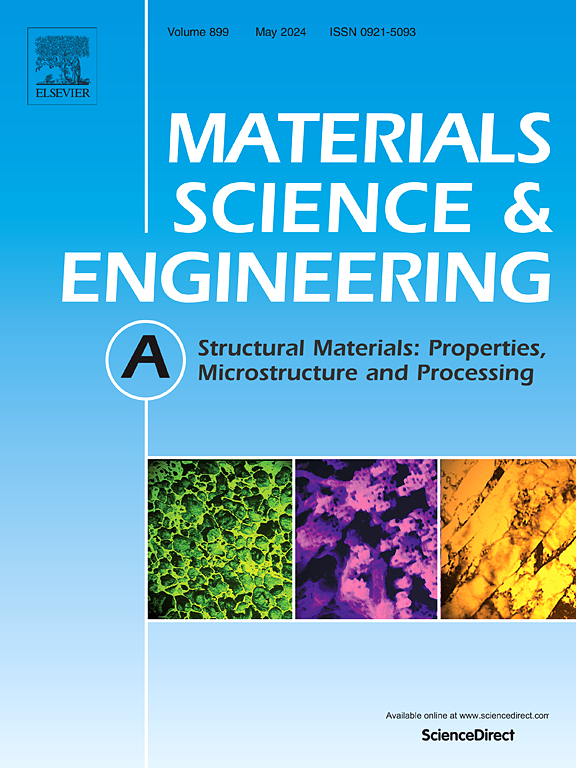坚固的位错滑移能量格局和多滑移系统的协同激活使TiVZrNbAl(Mo)轻质多主元素合金具有卓越的强度-延性协同效应
IF 6.1
2区 材料科学
Q1 MATERIALS SCIENCE, MULTIDISCIPLINARY
引用次数: 0
摘要
耐火多主元素合金(rmpea)在千兆帕斯卡范围内具有优异的屈服强度,使其成为极端服务环境的有希望的候选者。然而,它们的高密度和有限的室温拉伸塑性限制了它们的加工性能和工业适用性。本研究设计了一系列轻量化rmpea,标称成分为(Ti50V20Zr12Nb12Al6)100-xMox (x = 0,2.5, 5)。显微组织分析表明,无mo的M0和2.5 at。掺钼的M2.5合金通过spinodal分解(SD)形成BCC1/BCC2双相调制结构,实现了优异的强度-延性协同效应。其屈服强度分别为952 MPa和1056 MPa,断裂伸长率分别为28.8%和22.6%,超过了大多数报道的rmpea和商用钛合金。相比之下,5。掺钼M5合金由于过量的C-14 Laves相析出和位错滑移受限导致了严重的塑性损失。优越的屈服强度源于显著的原子尺寸和模量不匹配,而增强的延性是由具有边缘特征的非螺位错和多滑移系统激活主导的变形机制造成的。这种行为归因于SD和晶格畸变引起的凹凸不平的能量格局,这增加了位错滑动阻力,并将变形从螺旋型位错主导转变为非螺旋型位错主导。最小不稳定层错能差(γUSF <;5%)介于{110}<;111>;{112} <111>;滑动系统促进顺序多滑动激活。这增强了应变硬化,延缓了塑性不稳定性,拓宽了塑性变形范围。该研究为轻量化、强强度rmpea的设计提供了一个新的范例,提高了它们在结构应用中的潜力。本文章由计算机程序翻译,如有差异,请以英文原文为准。
Rugged dislocation slip energy landscape and coordinated activation of multi-slip systems enable superior strength-ductility synergy in TiVZrNbAl(Mo) lightweight multi-principal element alloys
Refractory multi-principal element alloys (RMPEAs) possess exceptional yield strengths in the gigapascal range, positioning them as promising candidates for extreme service environments. However, their high density and limited tensile ductility at room temperature restrict their processability and industrial applicability. This study designed a series of lightweight RMPEAs with nominal compositions of (Ti50V20Zr12Nb12Al6)100-xMox (x = 0, 2.5, 5). Microstructural analysis revealed that the Mo-free M0 and 2.5 at.% Mo-doped M2.5 alloys develop a BCC1/BCC2 dual-phase modulated structure through spinodal decomposition (SD), achieving an exceptional strength-ductility synergy. Their yield strengths of 952 MPa and 1056 MPa and fracture elongations of 28.8 % and 22.6 %, respectively, surpass most reported RMPEAs and commercial titanium alloys. In contrast, the 5 at.% Mo-doped M5 alloy experiences severe ductility loss due to excessive C-14 Laves phase precipitation and restricted dislocation slip. The superior yield strength originates from significant atomic-size and modulus mismatches, while the enhanced ductility results from a deformation mechanism dominated by non-screw dislocations with edge character and the activation of multiple slip systems. This behavior is attributed to the rugged energy landscape induced by SD and lattice distortion, which increases dislocation glide resistance and shifts deformation from screw-to non-screw-type dislocation dominance. Additionally, the minimal unstable stacking fault energy differences (γUSF < 5 %) between {110} <111> and {112} <111> slip systems promote sequential multi-slip activation. This enhances strain hardening, delays plastic instability, and broadens the plastic deformation regime. This study provides a new paradigm for designing lightweight, strong RMPEAs, advancing their potential in structural applications.
求助全文
通过发布文献求助,成功后即可免费获取论文全文。
去求助
来源期刊

Materials Science and Engineering: A
工程技术-材料科学:综合
CiteScore
11.50
自引率
15.60%
发文量
1811
审稿时长
31 days
期刊介绍:
Materials Science and Engineering A provides an international medium for the publication of theoretical and experimental studies related to the load-bearing capacity of materials as influenced by their basic properties, processing history, microstructure and operating environment. Appropriate submissions to Materials Science and Engineering A should include scientific and/or engineering factors which affect the microstructure - strength relationships of materials and report the changes to mechanical behavior.
 求助内容:
求助内容: 应助结果提醒方式:
应助结果提醒方式:


